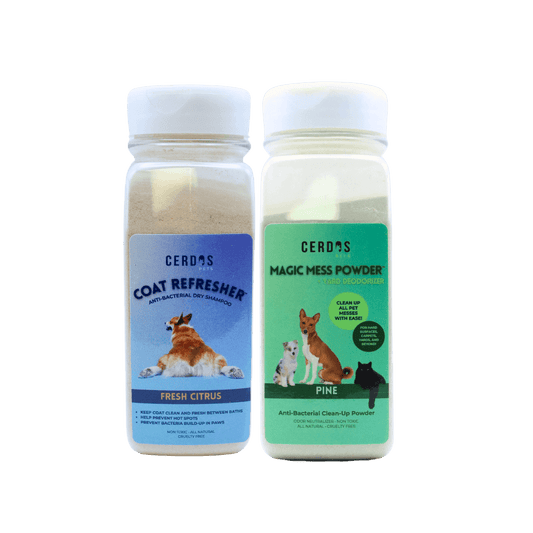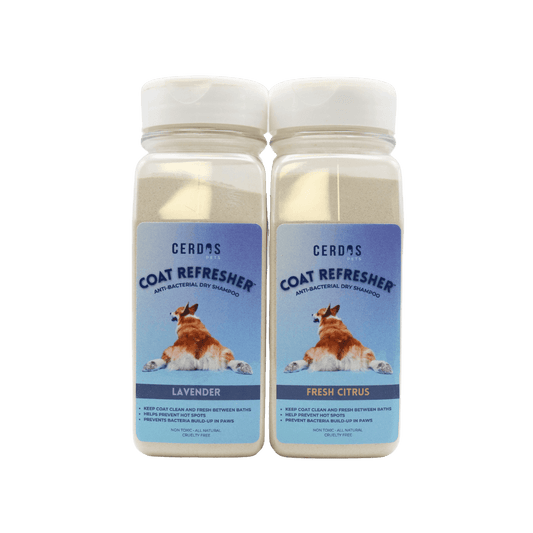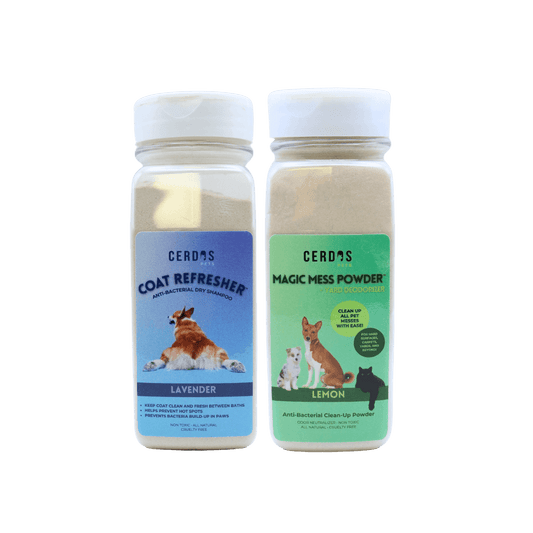Top Harmful Ingredients to Avoid in Pet Grooming Products
Table of content
Have you ever wondered what ingredients are in your pet products? If not, you should. Your pet’s skin is their largest organ. Since pets groom themselves by licking their coats and skin, residue can be swallowed, leading to irritation, illness, or even worse…

The following is a list of veterinary-backed findings regarding the worst ingredients commonly used in pet grooming products. For each ingredient, we identify how it is harmful, to which species (dog, cat, or both), and what the usual signs or health hazards of exposure are. Refer to this list (and the summary table) as your guide for keeping your pets safe!
Start by Looking Over Your Current Pet Grooming Ingredients
Product labels on pet grooming items can be pretty confusing. Sometimes they use unclear or even contradictory terms. Believe it or not, the same ingredient might be called a gentle skin irritant on one label and a possible cancer risk on another, all depending on how it was made.

It gets even trickier when you realize that most grooming brands don’t make their own raw ingredients. Instead, they buy ready-made components from chemical suppliers and mix them to create the final product. For example, your dog’s shampoo brand probably isn’t making sodium lauryl sulfate from scratch using coconut oil, they’re likely just buying it from someone else.
This is why it's important to check the labels on your pet products and make sure to avoid harmful ingredients. Or you could buy from Cerdos Pets and know you are getting quality, all-natural, locally-made pet products.
Harmful Pet Grooming Ingredients to Avoid

1. Pyrethrins & Pyrethroids (Permethrin)
Pyrethrins are natural insecticidal compounds from chrysanthemums, and pyrethroids like permethrin are their synthetic cousins, often used in flea and tick shampoos and sprays. Dogs can also be harmed if they ingest large amounts or if small breeds/puppies are overexposed, but they are extremely toxic to cats.
Why they are harmful
These chemicals overstimulate the nervous system. In cats, exposure (often from using dog flea shampoo on a cat or close contact with a treated dog) causes severe neurotoxicity.
Symptoms of exposure
Unusual drooling, tremors, twitching, seizures, difficulty breathing, and potentially death if untreated. Dogs with pyrethroid overdose may show muscle tremors or vomiting as well.
2. Tea Tree Oil (Melaleuca)

Why it is harmful
Tea tree oil contains terpenes that damage the liver and nervous system when absorbed or ingested.
Symptoms of exposure
Weakness, inability to walk or hind-limb paralysis, drooling, vomiting, low body temperature, liver enzyme elevation, tremors or seizures, and coma.
3. Parabens (Preservative Chemicals)
Parabens are antimicrobial preservatives used to prolong the shelf life of pet grooming products. They are often found in some pet shampoos and sprays. Parabens have become controversial because they can cause allergic reactions in pets and have potential hormone-disrupting effects. Dogs have relatively thinner and more sensitive skin than humans, and parabens may trigger irritation or worse in some animals.
Why it is harmful
Parabens can be absorbed through the skin and may act as endocrine disruptors (hormones), mimicking hormones (as seen in lab studies).
Symptoms of exposure
Red, itchy rashes, skin irritation, hair loss, or hives are common signs of paraben allergy in dogs. Sensitive dogs might also experience dry, flaky skin or even vomiting and diarrhea in severe allergic reactions.
4. Artificial Fragrances & Phthalates
Everyone loves a good-smelling pet, but that “fresh breeze” or “baby powder” shampoo scent often comes from artificial fragrance mixtures. These mixtures can contain hundreds of chemicals, including solvents and fixatives like phthalates. Phthalates are known hormone disruptors, and many synthetic fragrance ingredients have been linked to allergies or even cancer.
Additionally, pets have a far stronger sense of smell than humans, and a heavily perfumed shampoo can be overwhelming or irritating to them.
Why it is harmful
Phthalates in fragrances disrupt the endocrine system, potentially affecting reproductive hormones and thyroid function. Other fragrance compounds (some are petroleum derivatives like benzene-based chemicals) can cause neurologic and respiratory problems in pets.
Symptoms of exposure
Immediately, a pet might start sneezing, coughing, or showing eye discharge if a shampoo’s fragrance is too strong or irritating. They may scratch or rub at their face after a bath, indicating the scent or ingredients bother them.
Long-term, owners and vets have noted hormonal changes (like irregular heat cycles in dogs) that could be linked to phthalate exposure, though such effects are hard to see directly. Skin contact can also lead to allergic dermatitis in some pets (red itchy bumps).
5. Formaldehyde

Why it is harmful
Formaldehyde can cause an immune system reaction– even low levels on skin may lead to burning, itching, or scaling dermatitis in pets. If a pet licks the product, formaldehyde is toxic when ingested, and chronic exposure is linked to cancer.
Symptoms of exposure
Skin irritation (redness, itching, sores) is the biggest risk with formaldehyde releasers. Pets with sensitive skin might develop chronic eczema or inflammation. If significant formaldehyde is ingested, it could cause oral and gastric irritation (drooling, vomiting). Long-term, there is concern about increased cancer risk with repeated benzene or formaldehyde exposure.
6. Sulfates
Many pet shampoos use sulfate detergents like sodium lauryl sulfate (SLS) or sodium laureth sulfate (SLES) to create lather and clean dirt. These are the same foaming agents found in human shampoos and dish soaps, but they can be harsh on pets’ skin. Sulfates strip natural oils, often leaving the skin dry and irritated.
Why they are harmful
SLS/SLES are anionic detergents that can cause cellular irritation. In pets, they can disrupt the skin’s protective barrier, leading to dryness and inflammation. Importantly, if a cat licks and inhales shampoo containing SLS, it may interfere with the cat’s lung surfactant, leading to breathing problems.
Symptoms of exposure
Dry, flaky, or red skin, itching, and a dull coat due to stripped natural oils. Prolonged use can contribute to chronic dermatitis. Pets (especially cats) may also sneeze or have runny eyes if shampoo gets in the nose/eyes, since sulfates are mucous membrane irritants.
7. Artificial Colors and Dyes
Artificial colors (FD&C dyes) are added to some pet shampoos or sprays purely for visual appeal– for example, to make a shampoo pretty blue or green. These dyes do nothing for cleansing… in fact, they can bring potential risks. Some artificial food/color dyes have been linked to health issues (like certain blues and reds linked to tumors in lab animals).
Why they are harmful
Artificial dyes are chemical additives that may contain impurities (arsenic or lead traces have been found in some batches of food dyes historically). They have been associated with problems like organ damage, cancer, and birth defects in high doses during animal testing.
Symptoms of exposure
A pet allergic to a dye might develop localized redness or hives in areas the colored shampoo touched (often the back or top of the head). Ingesting a bit of dye while grooming might cause mild stomach upset (drooling, vomiting, or loose stool).
8. Cocamide DEA
These are surfactants and foam boosters derived from coconut oil, used to thicken shampoos and make them lather well. Cocamide DEA (cocamide diethanolamine) and related compounds like cocamide MEA or TEA, as well as cocamidopropyl betaine (CAPB), are common in pet and human shampoos marketed as “mild” or “natural” (because they come from coconut oil). However, during their manufacture, they are combined with reactive chemicals that can leave behind harmful residues. Cocamide DEA, in particular, has been flagged as a possible carcinogen. Yikes!
Why it is harmful
Cocamide DEA/MEA are ethanolamine compounds; if they react with nitrites (sometimes present as contaminants or in water), they can form carcinogenic nitrosamines (bad chemicals you want to avoid).
Symptoms of exposure
Most commonly, a pet regularly bathed in a shampoo containing these may develop itchy, irritated skin or recurrent ear infections (if residue gets in the ears). Allergic pets might get bumps or blotches on the skin. These ingredients typically do not cause acute poisoning, but the concern is more about long-term health risks.
9. Alcohol (Isopropyl Alcohol)
Some pet grooming sprays and ear cleaners contain alcohol (often listed as isopropanol or SD Alcohol-40). While small amounts help in drying the coat or killing microbes, alcohol is very drying and can be toxic if licked in quantity. Isopropyl alcohol, in particular, is much stronger than ethanol (drinking alcohol), and pets are more sensitive to it.
Why it is harmful
Topically, alcohol dries out the skin, leading to flakiness and irritation. It can also enhance skin absorption of other chemicals, effectively “driving” toxins deeper.
Symptoms of exposure
Watch for red, dry, or cracked skin on your pet – a sign the product is too harsh. If ingested, drooling, vomiting, incoordination, depression, or tremors may be seen. In severe cases, low body temperature, low blood pressure, collapse, or seizures can occur due to alcohol poisoning.
Don't Risk Your Pet's Health, Use Cerdos Pet Products for Peace of Mind
Don’t risk your pet’s health. When searching for your next pet product, search for natural or certified organic ingredients. At Cerdos Pets, we believe peace of mind starts with transparency and trust.

Give your pet the care they deserve: explore our full line of grooming essentials and learn more about our mission to raise the standard in pet wellness.






